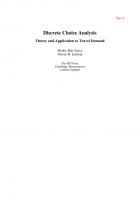Environmental Valuation with Discrete Choice Experiments: Guidance on Design, Implementation and Data Analysis 3030626687, 9783030626686
This open access book offers up-to-date advice and practical guidance on how to undertake a discrete choice experiment a
423 85 2MB
English Pages 129 [136] Year 2021
Table of contents :
Preface
References
Contents
Abbreviations
1 Theoretical Background
1.1 Welfare Economics
1.2 Random Utility Maximisation Model
References
2 Developing the Questionnaire
2.1 Structure of the Questionnaire
2.2 Description of the Environmental Good
2.3 Survey Pretesting: Focus Groups and Pilot Testing
2.4 Incentive Compatibility
2.5 Consequentiality
2.6 Cheap Talk, Opt-Out Reminder and Oath Script
2.7 Instructional Choice Sets
2.8 Identifying Protesters
2.9 Identifying Strategic Bidders
2.10 Payment Vehicle and Cost Vector Design
References
3 Experimental Design
3.1 The Dimensionality of a Choice Experiment
3.1.1 Number of Choice Tasks
3.1.2 Number of Attributes
3.1.3 Number of Alternatives
3.1.4 Other Dimensionality Issues
3.2 Statistical Design of the Choice Tasks
3.3 Checking Your Statistical Design
References
4 Collecting the Data
4.1 Sampling Issues
4.2 Survey Mode (Internet, Face-To-Face, Postal)
References
5 Econometric Modelling: Basics
5.1 Coding of Attribute Levels: Effects, Dummy or Continuous
5.2 Functional Form of the Attributes in the Utility Function
5.3 Econometric Models
5.3.1 Multinomial (Conditional) Logit
5.3.2 Mixed Logit Models—Random Parameter, Error Component and Latent Class Models
5.3.3 G-MXL Model
5.3.4 Hybrid Choice Models
5.4 Coefficient Distribution in RP-MXL
5.5 Specifics for the Cost Attribute
5.6 Correlation Between Random Coefficients
5.7 Assuring Convergence
5.8 Random Draws in RP-MXL
References
6 Econometric Modelling: Extensions
6.1 WTP-Space Versus Preference Space
6.2 Scale Heterogeneity
6.3 Information Processing Strategies
6.4 Random Regret Minimisation—An Alternative to Utility Maximisation
6.5 Attribute Non-attendance
6.6 Anchoring and Learning Effects
References
7 Calculating Marginal and Non-marginal Welfare Measures
7.1 Calculating Marginal Welfare Measures
7.2 Aggregating Welfare Effects
7.3 WTP Comparison
References
8 Validity and Reliability
8.1 The Three Cs: Content, Construct and Criterion Validity
8.2 Testing Reliability
8.3 Comparing Models
8.3.1 Model Fit-Based Strategies to Choose Among Different Models
8.3.2 Cross Validation
8.4 Prediction
References
9 Software
References
Preface
References
Contents
Abbreviations
1 Theoretical Background
1.1 Welfare Economics
1.2 Random Utility Maximisation Model
References
2 Developing the Questionnaire
2.1 Structure of the Questionnaire
2.2 Description of the Environmental Good
2.3 Survey Pretesting: Focus Groups and Pilot Testing
2.4 Incentive Compatibility
2.5 Consequentiality
2.6 Cheap Talk, Opt-Out Reminder and Oath Script
2.7 Instructional Choice Sets
2.8 Identifying Protesters
2.9 Identifying Strategic Bidders
2.10 Payment Vehicle and Cost Vector Design
References
3 Experimental Design
3.1 The Dimensionality of a Choice Experiment
3.1.1 Number of Choice Tasks
3.1.2 Number of Attributes
3.1.3 Number of Alternatives
3.1.4 Other Dimensionality Issues
3.2 Statistical Design of the Choice Tasks
3.3 Checking Your Statistical Design
References
4 Collecting the Data
4.1 Sampling Issues
4.2 Survey Mode (Internet, Face-To-Face, Postal)
References
5 Econometric Modelling: Basics
5.1 Coding of Attribute Levels: Effects, Dummy or Continuous
5.2 Functional Form of the Attributes in the Utility Function
5.3 Econometric Models
5.3.1 Multinomial (Conditional) Logit
5.3.2 Mixed Logit Models—Random Parameter, Error Component and Latent Class Models
5.3.3 G-MXL Model
5.3.4 Hybrid Choice Models
5.4 Coefficient Distribution in RP-MXL
5.5 Specifics for the Cost Attribute
5.6 Correlation Between Random Coefficients
5.7 Assuring Convergence
5.8 Random Draws in RP-MXL
References
6 Econometric Modelling: Extensions
6.1 WTP-Space Versus Preference Space
6.2 Scale Heterogeneity
6.3 Information Processing Strategies
6.4 Random Regret Minimisation—An Alternative to Utility Maximisation
6.5 Attribute Non-attendance
6.6 Anchoring and Learning Effects
References
7 Calculating Marginal and Non-marginal Welfare Measures
7.1 Calculating Marginal Welfare Measures
7.2 Aggregating Welfare Effects
7.3 WTP Comparison
References
8 Validity and Reliability
8.1 The Three Cs: Content, Construct and Criterion Validity
8.2 Testing Reliability
8.3 Comparing Models
8.3.1 Model Fit-Based Strategies to Choose Among Different Models
8.3.2 Cross Validation
8.4 Prediction
References
9 Software
References

- Author / Uploaded
- Petr Mariel
- David Hoyos
- Jürgen Meyerhoff
- Mikolaj Czajkowski
- Thijs Dekker
- Klaus Glenk
- Jette Bredahl Jacobsen
- Ulf Liebe
- Søren Bøye Olsen
- Julian Sagebiel
- Mara Thiene
- Similar Topics
- Economy
![Environmental Valuation with Discrete Choice Experiments: Guidance on Design, Implementation and Data Analysis [1st ed.]
9783030626686, 9783030626693](https://ebin.pub/img/200x200/environmental-valuation-with-discrete-choice-experiments-guidance-on-design-implementation-and-data-analysis-1st-ed-9783030626686-9783030626693.jpg)


![Environmental Data Analysis With Matlab [1 ed.]
0123918863, 9780123918864](https://ebin.pub/img/200x200/environmental-data-analysis-with-matlab-1nbsped-0123918863-9780123918864.jpg)



![Design and Analysis of Experiments [part 2, 5th Edition]](https://ebin.pub/img/200x200/design-and-analysis-of-experiments-part-2-5th-edition.jpg)
